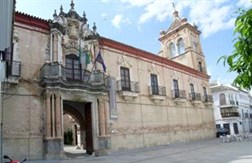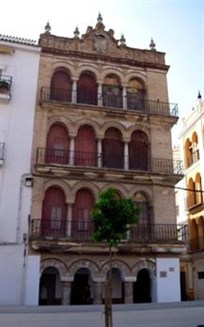Écija
 In Écija, a city of the province of Seville, in Andalusia, there are tangible signs of the presence of the Marquises of Benamejí in the Early Modern period which are artistically important. The palace of Benamejí is a Baroque palace which has been declared a cultural and national monument which began to be built at the beginning of the eighteenth century. Just as another palace in the same town, that of Peñaflor, it is one of the models of Baroque civil architecture in Spain and one of the jewels of the Golden Age of Écija. Originally, the palace was the property of the Marquises of Benamejí, a branch of the French house of Bernuy. It later passed onto the Counts of Valverde, a family line which was extinguished in 1874. Afterwards, it housed a military barracks and from 1997 is the home of the city museum. The imposing façade (photo 1) is in brick, with a base in stone and a row of balconies on the first floor, according to the project of the local architect Pablo Gutiérrez. Two large observatory towers on the sides give a certain verticality to the building, breaking with the lines which are markedly horizontal. The monotony and the sobriety are also interrupted by the majestic portal which is formed by two levels and on the top there are five pinnacles of different heights and the coat of arms of the Marquises of Benamejí.
In Écija, a city of the province of Seville, in Andalusia, there are tangible signs of the presence of the Marquises of Benamejí in the Early Modern period which are artistically important. The palace of Benamejí is a Baroque palace which has been declared a cultural and national monument which began to be built at the beginning of the eighteenth century. Just as another palace in the same town, that of Peñaflor, it is one of the models of Baroque civil architecture in Spain and one of the jewels of the Golden Age of Écija. Originally, the palace was the property of the Marquises of Benamejí, a branch of the French house of Bernuy. It later passed onto the Counts of Valverde, a family line which was extinguished in 1874. Afterwards, it housed a military barracks and from 1997 is the home of the city museum. The imposing façade (photo 1) is in brick, with a base in stone and a row of balconies on the first floor, according to the project of the local architect Pablo Gutiérrez. Two large observatory towers on the sides give a certain verticality to the building, breaking with the lines which are markedly horizontal. The monotony and the sobriety are also interrupted by the majestic portal which is formed by two levels and on the top there are five pinnacles of different heights and the coat of arms of the Marquises of Benamejí.
 Entering the door, an enormous arch welcomes the visitor and the principal staircase can be seen which is formed by three arches on Doric columns and the cupula is covered by a barrel vault. On the right there are the old stalls, which currently host an exposition which brings together archeological vestiges which were recovered near the Plaza de España. Passing under the stairs one enters the principal courtyard which is bordered by a colonnade on two floors, with a rounded arch sustained by stone columns and with a fountain in the centre. The halls of the city museum are situated around the courtyard. The pieces of the museum come from material which was found in city excavations sites, components which were already present in the local archeological collection, donations or in temporary deposit. Among these are great mosaics of high quality and the Roman sculpture of the wounded Amazon, the only one in the world which has almost perfectly preserved its original polychrome colour.
Entering the door, an enormous arch welcomes the visitor and the principal staircase can be seen which is formed by three arches on Doric columns and the cupula is covered by a barrel vault. On the right there are the old stalls, which currently host an exposition which brings together archeological vestiges which were recovered near the Plaza de España. Passing under the stairs one enters the principal courtyard which is bordered by a colonnade on two floors, with a rounded arch sustained by stone columns and with a fountain in the centre. The halls of the city museum are situated around the courtyard. The pieces of the museum come from material which was found in city excavations sites, components which were already present in the local archeological collection, donations or in temporary deposit. Among these are great mosaics of high quality and the Roman sculpture of the wounded Amazon, the only one in the world which has almost perfectly preserved its original polychrome colour.
In Écija, one can also admire the Mirador Benamejí (photo 2). It is one of the buildings from which the nobles of the city used to watch the public celebrations which took place in the main square. Built in the eighteenth century, it is composed of four orders of arches. On its three floors there are wide porticos with colonnades while at the centre the upper cornice is dominated by the heraldry of the marquises who were the owners of the palace.
